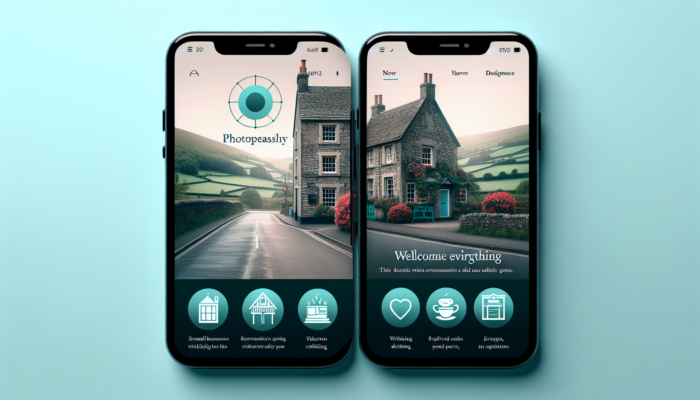Serving local customers for over 25 years.
Trusted by local business for reliable website design, SEO services and Digital Marketing in Somerset, Dorset, Devon, Wiltshire and Gloucestershire. 30 years of online marketing experience across the world.
Table of Contents
ToggleMastering the Fundamentals of Internet Marketing
Defining Internet Marketing for Business Growth

Internet marketing, frequently termed digital marketing, encompasses various strategies designed to promote products or services via online platforms. This multidimensional approach empowers businesses to connect with expansive audiences through various digital channels such as search engines, social media, email, and dedicated websites. As the transition from traditional to digital mediums accelerates, a thorough understanding of this realm is crucial for any business aiming to flourish in today’s fiercely competitive market.
The core of internet marketing solutions lies in leveraging the internet's vast capabilities to amplify visibility and foster engagement. By implementing techniques such as search engine optimisation (SEO), Pay-per-click (PPC) advertising, and content marketing, organisations can customise their strategies to target specific demographics, ensuring their messaging resonates with prospective customers. This targeted outreach isn’t just about disseminating information; it’s about engaging with audiences in a manner that feels personalised and contextually relevant.
The strategic amalgamation of these elements allows businesses to market their offerings effectively and cultivate enduring relationships with their clientele. As firms adjust to the rapid advancements in digital tools, adopting comprehensive internet marketing strategies becomes increasingly critical. The competitive advantage gained through proficient internet marketing is substantial, establishing it as a pillar of contemporary business practices.
Transformative Advantages of Internet Marketing
The advantages of Internet marketing solutions are both numerous and transformative. One of the most compelling benefits is the potential for cost-effective advertising. Traditional marketing channels, such as print media or television, often necessitate significant financial investments. In contrast, digital marketing campaigns can be tailored to accommodate any budget, enabling businesses of all sizes to flourish in their respective markets.
Targeted outreach represents another pivotal benefit of Internet marketing. With the introduction of advanced analytics and segmentation tools, businesses can now channel their marketing efforts towards specific consumer groups that are more likely to convert. For instance, companies can develop targeted campaigns based on user demographics, interests, and behaviours by utilising platforms like Google Ads and Facebook advertising, ensuring their marketing messages resonate effectively.
Additionally, the quantifiable results associated with Internet marketing solutions empower businesses to monitor their effectiveness in real time. Every interaction, click, and conversion can be measured, providing invaluable insights into consumer behaviour and campaign performance. This data-driven approach facilitates the optimisation of ongoing campaigns and informs future marketing strategies for improved effectiveness.
Another invaluable aspect is the capability to engage with customers instantaneously. Social media platforms and email marketing provide brands with the tools to connect with their audiences promptly, addressing inquiries and feedback without delay. This immediacy enhances customer trust and loyalty and establishes a brand presence that feels accessible and responsive to consumer needs.
Exploring the Varieties of Internet Marketing
Delving into the various internet marketing solutions, we uncover several prominent strategies businesses can implement. Search engine optimisation (SEO) is a fundamental technique to enhance a website's visibility on search engine results pages. By optimising website content, structure, and on-page elements such as meta tags, businesses can elevate their organic search rankings, thus driving increased website traffic.
Pay-per-click (PPC) advertising is another potent strategy, enabling businesses to purchase visibility on search engine results pages. With PPC, advertisers incur costs only when a user clicks on their ad, making it a highly efficient method for driving targeted traffic to a website.
Content marketing plays a crucial role within the digital ecosystem. Businesses can effectively attract and engage their target audiences by producing valuable and relevant content. This strategy nurtures brand loyalty and complements SEO initiatives, as quality content often leads to improved search rankings and greater online authority.
Furthermore, social media marketing has revolutionised the way brands interact with consumers. Platforms such as Facebook, Instagram, and LinkedIn facilitate direct interaction and engagement, fostering communities around brands and cultivating customer loyalty.
Lastly, email marketing remains a steadfast tool in the arsenal of Internet marketing solutions. By nurturing leads through targeted email campaigns, businesses can sustain ongoing customer relationships, providing promotions, updates, and personalised content that encourage conversions and engagement.
Formulating Key Strategies for Impactful Internet Marketing

Implementing effective strategies is essential for businesses aiming to use Internet marketing solutions. Establishing a strong online presence is foundational. This entails creating a visually appealing website that is user-friendly, optimised for mobile devices, and equipped with essential information that promotes user engagement.
Another key strategy is leveraging data analytics. By employing tools like Google Analytics, businesses can obtain insights into user behaviour, sources of traffic, and conversion rates. This data can inform marketing decisions, enabling businesses to pivot and adjust their strategies based on real-time feedback and performance metrics.
Continuous campaign optimisation enhances performance and return on investment (ROI). A successful internet marketing strategy is dynamic and necessitates ongoing evaluation and refinement. By A/B testing various elements of marketing campaigns, businesses can identify what resonates best with their audience and improve their messaging accordingly.
Establishing a robust brand voice and maintaining consistency across all digital platforms contribute significantly to effective internet marketing. Ensuring that all communications reflect brand values and resonate with the target audience fosters trust and recognition, ultimately enhancing customer loyalty.
In summary, integrating these strategies empowers businesses to establish a comprehensive internet marketing approach that attracts and retains customers, securing long-term success in an ever-evolving digital landscape.
Navigating Challenges in Internet Marketing
While the benefits of Internet marketing solutions are considerable, businesses must also tackle various challenges within the digital marketing landscape. One significant obstacle is keeping pace with rapid technological advancements. The digital environment evolves astonishingly, with new tools, platforms, and strategies emerging regularly. Companies must remain informed and adaptable to leverage these changes effectively.
Managing online reputation is another challenge that demands attention. Businesses must actively monitor and respond to customer interactions in a world where customer reviews and social media feedback can significantly influence public perception. Allowing negative reviews to go unaddressed can rapidly damage a brand's reputation, making proactive reputation management essential for maintaining public trust.
Navigating the complexities of data privacy regulations also presents additional hurdles. Regulations such as GDPR in Europe and CCPA in California dictate how businesses can collect and use consumer data, and companies must ensure compliance to avoid substantial fines and loss of consumer trust.
Moreover, understanding the intricacies of various digital marketing platforms and their algorithms can be daunting. Each platform possesses its own rules and best practices, and what proves effective on one may not yield the same results on another. Businesses must invest time and resources into researching these factors to optimise their strategies efficiently.
Despite these challenges, the rewards of Internet marketing solutions far surpass the potential pitfalls. With careful planning, continuous education, and a commitment to adaptation, companies can navigate this intricate landscape and position themselves for enduring success.
Strategic SEO Approaches for Enhanced Visibility
Implementing On-Page SEO Techniques for Success

Effective SEO is rooted in on-page techniques, which are critical in how search engines interpret website content. By meticulously optimising website elements, businesses can significantly enhance their visibility on search engine results pages (SERPs). This process includes refining meta titles and descriptions, which represent users' first interaction with a webpage. An enticing meta description captures attention and encourages clicks, which is vital to a comprehensive SEO strategy.
Another essential aspect of on-page optimisation is strategically incorporating relevant keywords within website content. By understanding potential customers' search terms, businesses can effectively place these keywords throughout their text, headers, and image alt tags. However, it’s crucial to maintain a balance; excessive keyword usage, known as keyword stuffing, can lead to search engine penalties. The focus should be on creating high-quality, engaging content, seamlessly integrating keywords, and enhancing readability and SEO value.
Moreover, improving website loading speed is of the utmost importance. Research indicates that even a one-second delay in page load time can significantly decline customer satisfaction and conversion rates. Optimising image sizes, leveraging browser caching, and minimising HTTP requests are vital in enhancing site performance and delivering a seamless user experience that search engines favour.
Another integral element of on-page SEO is the implementation of internal linking. By linking to other relevant pages within the site, businesses can improve users' navigation while assisting search engines in comprehending the site’s structure and hierarchy. This practice enhances the user experience and distributes page authority across the site, boosting overall rankings.
A holistic approach to on-page SEO is essential for maximising online visibility and driving organic traffic. By concentrating on these techniques, businesses can establish a robust foundation for their broader SEO efforts and cultivate an authoritative presence within their respective industries.
Leveraging Off-Page SEO Techniques for Authority
While on-page SEO focuses on elements within a website, off-page SEO encompasses activities conducted outside the website to enhance its authority and rankings on search engines. One of the most effective off-page techniques is backlink building. Backlinks serve as endorsements from other websites; the more quality backlinks a site accumulates, the more authoritative it appears to search engines. To cultivate backlinks, businesses can engage in guest blogging, collaborate with influencers, or participate in industry forums.
Social signals also significantly impact off-page SEO. Although social media engagement does not directly influence search rankings, it greatly enhances visibility and drives website traffic. By producing shareable content and promoting it across social platforms, businesses can boost their brand awareness and attract potential backlinks from other sites, further amplifying their SEO efforts.
Another effective off-page SEO strategy involves utilising online directories and local listings. For businesses seeking to attract local customers, being featured on platforms like Google My Business, Yelp, and industry-specific directories can profoundly impact visibility. These listings provide essential information, such as address and contact details, and contribute to local search rankings.
Online reputation management is an often overlooked aspect of off-page SEO. Actively monitoring brand mentions, responding to reviews, and engaging with customers on social media can enhance a brand’s reputation, making it more appealing to users and search engines. Positive reviews and interactions signal to search engines that a brand is reputable and trustworthy, influencing search rankings.
In conclusion, mastering off-page SEO techniques is vital for businesses aiming to bolster their online visibility. By building quality backlinks, engaging on social media, maintaining accurate local listings, and managing their reputation, companies can enhance their website’s authority and improve their overall search engine performance.
Key Technical SEO Considerations for Optimal Performance
Technical SEO encompasses the behind-the-scenes elements contributing to a website's success in search rankings. Ensuring that a website is technically sound is imperative for facilitating search engine crawling and indexing, which ultimately influences visibility. One primary focus of technical SEO is website speed. Search engines, parnotably Google, prioritise fast-loading sites as they offer a superior user experience. Techniques such as minimising HTTP requests, optimising images, and using content delivery networks (CDNs) can significantly enhance load times.
Mobile friendliness is another crucial consideration in technical SEO. With the growing prevalence of mobile browsing, Google has adopted a mobile-first indexing approach, meaning it predominantly relies on a website's mobile version for indexing and ranking. Businesses must ensure that their websites are responsive and provide an optimal experience across all devices, improving user satisfaction and search rankings.
Site architecture also plays a pivotal role in technical SEO. A well-structured site facilitates better search engine crawling and enhances the user experience. A logical hierarchy with clear navigation enables users to locate content quickly, reducing bounce rates and promoting prolonged engagement. Implementing breadcrumb navigation and XML sitemaps can further assist search engines in understanding site structure and content relevance.
Additionally, addressing crawl errors is paramount for technical SEO. Regularly monitoring Google Search Console can assist in identifying issues such as broken links, duplicate content, and redirect errors. By promptly resolving these issues, businesses can enhance their site’s performance and ensure that search engines can effectively crawl and index their pages.
Focusing on technical SEO is critical for businesses aiming for optimal search engine performance. By prioritising speed, mobile-friendliness, site architecture, and error management, companies can create a solid foundation that supports their overall digital marketing strategies.
Conducting Thorough Keyword Research and Analysis
Keyword research and analysis form the cornerstone of successful SEO and content marketing strategies. By identifying the terms and phrases potential customers search for, businesses can tailor their content to meet user intent and enhance visibility on search engines. Effective keyword research begins with brainstorming potential keywords related to products or services. However, it extends beyond mere speculation; keyword research tools like Google Keyword Planner, SEMrush, or Ahrefs yield insights into search volume, competition, and keyword difficulty.
Once a comprehensive list of potential keywords is compiled, businesses should analyse their relevance and competitiveness. Long-tail keywords, which consist of more specific phrases that typically exhibit lower competition, can be particularly beneficial for smaller enterprises. By targeting these niche phrases, companies can attract highly relevant traffic that is more likely to convert into leads or sales.
Keywords must be incorporated into content with precision. This involves strategically placing them in titles, headers, and throughout the body text, ensuring a natural flow that enhances readability. Over-optimisation, known as keyword stuffing, can lead to search engine penalties, so it’s essential to maintain a balance between keyword integration and content quality.
Beyond mere inclusion, comprehending user intent behind keywords is paramount. Keywords can signify various types of intent, including informational, navigational, or transactional. By recognising the intent behind specific keywords, businesses can customise their content to meet the specifics of their audience, thereby enhancing engagement and conversion rates.
Finally, ongoing analysis and adjustments based on performance metrics are critical. Reviewing which keywords drive traffic, engagement, and conversions allows businesses to refine their strategies continually. By staying attuned to search trends and user behaviour, companies can adapt their keyword strategies effectively, ensuring ongoing visibility and relevance in search results.
Integrating Content Marketing with SEO for Success
Content marketing and SEO are interdependent strategies that, when executed effectively, can significantly enhance a business's online presence. Quality content is the cornerstone of successful SEO; search engines prioritise sites with valuable, engaging content that addresses user needs. Companies should create informative blog posts, articles, videos, and infographics that resonate with their target audience, enhancing user engagement and SEO performance.
Integrating targeted keywords into content is essential for optimising it for search engines. However, the primary focus should always be on delivering value to the reader. Content that educates, entertains, or solves problems is more likely to attract backlinks and social shares, which are vital for improving search rankings and online authority.
Moreover, a well-planned content distribution strategy can amplify the reach of SEO efforts. Sharing content on social media platforms, through email newsletters, and in industry forums helps attract traffic to the website while increasing its visibility. Engaging with the audience through these channels can also foster a community around a brand, enhancing loyalty and trust.
Another effective strategy to boost SEO is regularly updating and repurposing existing content. By refreshing outdated articles or converting blog posts into videos, businesses can breathe new life into valuable content, ensuring it continues to serve their audience while improving search performance.
The symbiotic relationship between content marketing and SEO cannot be overstated. By creating high-quality, relevant content and optimising it for search engines, businesses can enhance their visibility, drive traffic, and ultimately achieve their online marketing objectives.
Effective Content Marketing Practices
Crafting High-Quality, Valuable Content
Creating valuable content is a cornerstone of successful content marketing and vital to any effective internet marketing solutions strategy. Valuable content goes beyond mere information; it educates, entertains, or addresses specific problems for the target audience, establishing the brand as a trusted authority within its industry.
To develop resonated content, businesses must first cultivate a deep understanding of their audience's needs, preferences, and pain points. Conducting surveys, analysing social media interactions, and studying competitor content can provide critical insights into which topics will engage potential customers. By directly addressing these needs through informative articles, blog posts, videos, or podcasts, businesses can create content that not only garners attention but also nurtures trust and loyalty.
Furthermore, the format of the content plays a crucial role in its effectiveness. While written articles are fundamental, integrating diverse formats such as infographics, videos, and interactive content can cater to different learning preferences and maintain audience engagement. For instance, a complex topic may be more digestible when presented as an infographic or a video, enabling broader reach.
Consistency is another key factor in delivering valuable content. Establishing a content calendar and adhering to a regular publishing schedule keeps the audience engaged and returning for more. This consistency helps build brand recognition and reinforces the brand's authority in the industry.
Lastly, it’s essential to encourage engagement with the content. Inviting comments, questions, or social media shares enhances interaction and provides valuable feedback that can inform future content strategies. Engaging with the audience demonstrates that the brand values their opinions and fosters a sense of community.
In conclusion, valuable content creation is not merely about disseminating information; it's about understanding the audience and delivering content that meets their needs, fostering trust, and establishing authority within the industry.
Optimising Content Distribution Channels for Maximum Impact
The impact of valuable content can be significantly diminished without a robust distribution strategy to ensure it reaches the appropriate audience. Identifying and leveraging effective content distribution channels is vital for maximising reach and engagement. Social media platforms are among the most potent distribution avenues available. Networks like Facebook, Twitter, LinkedIn, and Instagram allow businesses to share content directly with their target audience, promoting engagement through shares, comments, and likes.
Tailoring content for each platform can enhance its effectiveness. For instance, visually engaging content, such as images or videos, may perform better on Instagram, while in-depth articles may be more suitable for LinkedIn audiences. Understanding the nuances of each platform enables businesses to optimise their content distribution strategies effectively.
Email marketing also remains a powerful channel for content distribution. By building a segmented email list, businesses can send targeted content directly to interested subscribers, nurturing leads and encouraging conversions. Personalisation is vital to email marketing success; tailored messages based on user behaviour or preferences can significantly improve open and click-through rates.
Additionally, guest posting on reputable industry blogs and websites can broaden a business's reach. By contributing high-quality content to other platforms, businesses can tap into established audiences, drive traffic to their website, and enhance their authority in the field.
Utilising online communities and forums relevant to the industry can also provide valuable distribution opportunities. Engaging in discussions and sharing pertinent content within these groups can position a brand as an authority and drive traffic to its website.
In summary, a successful content distribution strategy is multifaceted and incorporates various channels to maximise visibility and engagement. By understanding the strengths of each platform and tailoring content accordingly, businesses can ensure their valuable content effectively reaches the right audience.
Assessing Content Performance for Continuous Improvement
Measuring content performance is integral to understanding its effectiveness and informing future content strategies. By tracking key metrics, businesses can gain insights into what resonates with their audience, enabling them to refine their approach and enhance engagement.
A key metric to monitor is page views, which indicate how many users have accessed a particular content. High page views suggest the content is appealing, while low numbers may indicate a need for improvement in either content quality or distribution strategies.
Engagement rates offer another perspective on content performance. Metrics such as time on page, scroll depth, and social shares provide insights into how effectively the content holds the audience's attention. If users spend significant time on a page, it's a good indicator that the content is valuable and engaging. Conversely, high bounce rates may signal that the content does not meet user expectations or needs optimisation for better readability.
Conversion rates are perhaps the most critical metric for assessing the ultimate success of content. Whether the goal is to generate leads, drive sales, or encourage sign-ups, tracking how effectively content prompts users to take action provides insights into its effectiveness. A/B testing different calls-to-action and content formats can further optimise conversion rates by identifying what prompts users to engage.
Utilising analytics tools such as Google Analytics, social media insights, and email marketing metrics can provide a comprehensive overview of content performance. Reviewing these metrics helps assess current strategies and informs future content creation and distribution efforts.
In essence, measuring content performance is not a one-time task but an ongoing process that requires dedication to continuous improvement. By focusing on key metrics and making data-driven decisions, businesses can adapt their content strategies to meet audience needs better and enhance overall effectiveness.
Creating a Comprehensive Content Strategy
A well-defined content strategy is essential for guiding content creation and ensuring alignment with business objectives. By outlining clear goals, identifying the target audience, and determining the types of content to produce, businesses can create a cohesive approach that maximises the impact of their content marketing efforts.
The initial step in developing a content strategy is to establish specific goals. Whether the aim is to increase brand awareness, generate leads, or boost customer engagement, having clear objectives provides direction for all subsequent content decisions. These goals should be measurable to track progress and evaluate success over time.
Understanding the target audience is equally vital. Creating detailed buyer personas can assist businesses in identifying their audience's needs, preferences, and pain points. By tailoring content to address these elements, companies can ensure their messaging resonates and drives engagement.
Next, it is essential to determine the types of content to produce. Depending on audience preferences and the nature of the business, this may encompass blog posts, videos, infographics, or podcasts. A diverse content mix can cater to varying learning styles and maintain audience engagement.
Establishing a content calendar is invaluable for maintaining consistency and organisation. A well-structured calendar outlines publishing schedules, content topics, and distribution channels, ensuring content creation aligns with business priorities and seasonal trends.
Lastly, regularly evaluating content performance against established goals allows continual strategy refinement. This iterative process ensures that businesses remain agile and responsive to audience needs and market trends.
In conclusion, developing a comprehensive content strategy is vital for effective content marketing. Businesses can enhance their marketing efforts and drive meaningful results by establishing clear goals, understanding the audience, creating diverse content, and maintaining organisation through a content calendar.
Utilising User-Generated Content for Authentic Engagement
User-generated content (UGC) has emerged as a powerful tool in content marketing, providing businesses with authentic and relatable material that resonates with audiences. Encouraging customers to create and share content about a brand not only fosters community engagement but also enhances authenticity, making products and services more relatable and trustworthy.
One of the primary benefits of leveraging UGC is its cost-effectiveness. Instead of investing extensive resources in creating all content in-house, businesses can harness the creativity and perspectives of their customers. This collaborative approach not only diversifies content offerings but also increases engagement, as users are often more inclined to interact with content generated by their peers.
Social media campaigns encouraging users to share their experiences with a product or service can yield significant results. For instance, brands can create hashtags that customers can use when posting about their purchases. This increases brand visibility and creates a sense of community among users with similar interests or experiences.
Incorporating UGC into marketing materials, such as website galleries, ads, or promotional videos, can further enhance brand authenticity. Featuring real customers can humanise the brand, making it more approachable and relatable to potential buyers. This strategy can also stimulate word-of-mouth marketing, as customers feel valued and appreciated when showcasing their contributions.
However, businesses must implement strategies to encourage participation and leverage UGC effectively. This may involve hosting contests, offering incentives, or simply asking for feedback and contributions through social media. Engaging actively with users who submit content fosters a sense of community and encourages ongoing participation.
In summary, leveraging user-generated content is a dynamic way to enrich content marketing strategies. By encouraging customers to share their experiences and creatively showcasing their contributions, businesses can enhance authenticity, build community, and drive engagement, ultimately leading to increased customer loyalty and brand growth.
Maximising Social Media Marketing Potential
Selecting the Most Effective Social Media Platforms
Choosing the appropriate social media platforms is critical for maximising the effectiveness of social media marketing initiatives. With many platforms available, businesses must concentrate their resources on the channels where their target audience is most active. This targeted approach improves engagement and enhances the overall impact of marketing campaigns.
Understanding the demographics of each platform is foundational for making informed decisions. For instance, Facebook is known for its extensive user base, appealing to various age groups, while platforms like TikTok and Instagram tend to attract younger audiences. LinkedIn, conversely, serves as a professional networking site, making it ideal for B2B marketing. Businesses can effectively reach their desired audience by aligning marketing efforts with each platform's unique characteristics and user demographics.
Additionally, it is essential to consider the type of content that performs best on each platform. Visual content, such as images and videos, tends to perform well on platforms like Instagram and Pinterest, while Twitter is more suited for short, impactful updates and conversations. Businesses can enhance user engagement and interaction by tailoring content to fit the format and style of the chosen platforms.
A thorough analysis of competitors can also provide valuable insights into which platforms are most effective for a specific industry or audience. Observing where competitors successfully engage their followers can inform decision-making and inspire creative strategies to differentiate one’s brand.
Selecting the right social media platforms requires a strategic blend of understanding audience demographics, content preferences, and industry trends. Businesses can enhance their social media presence and optimise their marketing efforts by focusing on platforms that align with their target market.
Crafting Compelling and Engaging Social Content
Creating engaging social content is crucial for capturing and maintaining audience attention in the fast-paced world of social media. Businesses must focus on developing content that is not only relevant but also resonates emotionally with their audience. The key to effective social media content is understanding what motivates users to engage, share, and interact with posts.
Visual content is paramount on social media platforms. Posts featuring high-quality images, eye-catching graphics, or engaging videos garner higher engagement than text-only updates. Incorporating visually appealing elements can help convey messages more effectively and quickly capture the audience's attention. Furthermore, captivating videos, whether behind-the-scenes glimpses, product demonstrations, or customer testimonials, can significantly bolster user engagement.
Storytelling serves as another powerful technique for crafting engaging social content. By framing content within a narrative, businesses can evoke emotions and create a connection with their audience. Sharing stories about customer experiences, brand values, or community involvement can foster followers' sense of belonging and loyalty.
Integrating interactive elements into posts can also boost engagement. Polls, quizzes, and questions invite users to share their opinions and experiences, making them feel valued and encouraging further interaction. Additionally, hosting live sessions or Q&A events can facilitate real-time engagement, allowing businesses to connect directly with their audience and address their queries.
Posting consistently is vital for maintaining engagement. Establishing a content calendar helps ensure that posts are scheduled regularly, keeping the audience engaged and informed. Monitoring analytics to determine the best times for posting can further enhance visibility and interaction.
In summary, creating engaging social content requires a combination of visual appeal, storytelling, interactivity, and consistency. By focusing on these elements, businesses can capture audience attention, foster engagement, and cultivate a loyal online community.
Analysing Key Social Media Metrics for Success
Effectively analysing social media metrics is essential for understanding the success of marketing efforts and informing future strategies. By tracking key performance indicators (KPIs), businesses can gain insights into user engagement, content reach, and overall effectiveness.
Key metrics to monitor include follower growth, engagement, and click-through rates. Follower growth indicates a brand's expanding reach, while engagement rates—measured by likes, comments, and shares—reveal how well content resonates with the audience. Click-through rates provide insights into the effectiveness of calls to action and the overall performance of specific posts.
Additionally, sentiment analysis can offer valuable insights into audience perceptions. By examining comments and interactions, businesses can gauge how their audience feels about their brand, products, or services. This qualitative analysis can highlight areas for improvement or opportunities for engagement, allowing companies to adjust their strategies accordingly.
Utilising social media analytics tools—such as Facebook Insights, Twitter Analytics, or third-party platforms—can streamline tracking metrics. Regularly reviewing these analytics enables businesses to identify trends, assess the effectiveness of various content types, and refine their approach.
Analysing social media metrics is crucial for measuring success and optimising strategies. By leveraging data-driven insights, businesses can adapt their social media marketing efforts to meet audience needs better and drive meaningful engagement.
Harnessing the Power of Email Marketing
Building and Nurturing an Effective Email List
Building a robust email list is foundational to successful email marketing initiatives. An extensive and engaged email list empowers businesses to communicate directly with their target audience, nurturing leads and driving conversions. The initial step in this process is offering valuable incentives to encourage users to sign up. This could involve exclusive content, discounts, or downloadable resources that align with the target audience's interests.
Utilising opt-in forms strategically placed on websites and social media channels increases visibility and encourages subscriptions. Clear calls to action (CTAs) should guide users towards signing up, highlighting the benefits they will receive by joining the email list.
Additionally, segmenting the email list based on user demographics, interests, or behaviours can significantly enhance engagement. Tailoring content to specific segments allows businesses to deliver more relevant messages, thereby increasing the likelihood of conversions. For instance, sending personalised recommendations based on past purchases can elevate user experience and drive repeat business.
Regularly engaging with subscribers is crucial for maintaining an active email list. Sending welcome emails, newsletters, and updates on new products or promotions keeps the audience informed and connected. Furthermore, encouraging feedback can foster community, as subscribers feel their opinions are valued and appreciated.
Building an email list requires a strategic approach combining valuable incentives, strategic opt-in placements, and ongoing engagement. By nurturing these relationships, businesses can cultivate a loyal audience that is more likely to convert and advocate for their brand.
Designing Compelling and Effective Email Campaigns
Effective email campaigns are essential for driving engagement and conversions through email marketing. The success of an email campaign hinges on several key factors, beginning with the subject line. A compelling subject line makes a good first impression and can significantly impact open rates. It should be concise, engaging, and informative, enticing recipients to click and read further.
The content of the email must deliver value to the reader. Personalisation plays a crucial role here; addressing subscribers by name and tailoring content to their preferences can enhance relevance and encourage interaction. Including clear calls to action within the email helps guide recipients towards desired actions, whether purchasing, signing up for a webinar, or downloading a resource.
Moreover, the email's design should be visually appealing and mobile-friendly. A clean layout, engaging images, and concise text create a positive user experience. Testing different formats and designs can help identify what resonates best with the audience, improving overall effectiveness.
Timing and frequency of emails are also critical considerations. Sending emails at optimal times when recipients are most likely to engage can enhance open and click-through rates. Furthermore, maintaining a consistent schedule—whether weekly, bi-weekly, or monthly—helps establish expectations among subscribers and keeps the brand in mind.
Finally, analysing the performance of email campaigns is vital for continual improvement. Tracking metrics such as open rates, click-through rates, and conversion rates provides valuable insights into what works and what doesn’t. Regularly reviewing these metrics allows businesses to refine their email strategies, ensuring ongoing engagement and effectiveness.
In conclusion, crafting effective email campaigns requires a combination of compelling subject lines, personalised content, engaging design, strategic timing, and ongoing performance analysis. By focusing on these elements, businesses can enhance their email marketing efforts and drive meaningful results.
Evaluating Email Marketing Performance for Continuous Improvement
Analysing email marketing performance is crucial for understanding the effectiveness of campaigns and informing future strategies. By tracking key metrics, businesses can gain insights into user engagement and make data-driven decisions that optimise their email marketing efforts.
The KPIs to monitor include open, click-through, conversion, and unsubscribe rates. Open rates indicate how many recipients engage with the subject lines, while click-through rates reveal how many users interact with the email's content. High conversion rates signal that the email content is resonating with the audience and compelling them to take action.
Unsubscribe rates can provide critical insights into potential issues with email content or frequency. A sudden spike in unsubscribes may indicate that subscribers are not finding value in the emails being sent, prompting a need to reassess content strategy.
A/B testing different elements of emails—such as subject lines, content formats, and calls to action—can yield valuable insights into what resonates best with the audience. By experimenting with various approaches, businesses can continually refine their email marketing efforts, ensuring they remain relevant and engaging.
Utilising email marketing analytics tools can simplify the process of tracking and analysing performance metrics. These tools provide comprehensive reports and insights that allow businesses to assess the effectiveness of their campaigns and make informed adjustments.
In summary, analysing email marketing performance is an ongoing process that requires attention to key metrics and a willingness to adapt. Businesses can enhance their email marketing strategies by leveraging data-driven insights, ultimately driving higher engagement and conversions.
Understanding Pay-Per-Click Advertising
Demystifying Pay-Per-Click Advertising for Businesses
Pay-per-click (PPC) advertising is a powerful tool in the arsenal of Internet marketing solutions. It enables businesses to drive targeted traffic to their websites through paid advertisements. This model operates on a straightforward premise: advertisers pay a fee each time their ad is clicked, rendering it a cost-effective approach to generating leads and sales.
The primary platform for PPC advertising is Google Ads, which allows businesses to display ads on Google’s search results pages. By bidding on specific keywords, companies can ensure that their ads appear when users search for terms relevant to their offerings. This targeted approach enables businesses to connect with potential customers at a crucial moment in their buying journey, significantly enhancing the likelihood of conversions.
Crafting compelling copy is critical for success in PPC advertising. Advertisers must develop compelling, concise messages that capture users' attention and motivate them to click through. Incorporating strong calls to action and highlighting unique selling propositions can significantly augment the effectiveness of ads.
Moreover, ongoing PPC campaign optimisation is essential for maximising return on investment (ROI). Monitoring key metrics, such as click-through rates, conversion rates, and cost per acquisition, provides valuable insights into ad performance. Regular adjustments to bids, keyword refinement, and A/B testing of ad variations can lead to continual improvement and enhanced results.
In addition to search engine ads, businesses can explore display advertising options. Display ads appear on various websites within Google's Display Network, allowing for increased brand visibility and reach. Remarketing strategies can also be employed to re-engage visitors who previously interacted with the brand, reinforcing messaging and encouraging conversions.
In conclusion, PPC advertising presents a dynamic opportunity for businesses to drive targeted traffic and generate leads. By leveraging the power of platforms like Google Ads and continuously optimising campaigns, businesses can achieve significant results and enhance their overall internet marketing solutions.
Creating and Managing Effective PPC Campaigns
Creating effective pay-per-click (PPC) campaigns requires a strategic approach encompassing keyword selection, ad creation, and ongoing optimisation. The foundation of a successful PPC campaign lies in thorough keyword research. Identifying relevant keywords that align with user intent and possess sufficient search volume is essential for guaranteeing that ads reach the right audience.
Once keywords are determined, crafting compelling ad copy becomes paramount. Advertisements should be clear, persuasive, and tailored to address potential customers' needs. Including strong calls to action and highlighting unique selling propositions can significantly enhance click-through rates.
Landing pages play a critical role in the success of PPC campaigns. When users click on an ad, they should be directed to a relevant and user-friendly landing page that fulfills the promises made in the ad copy. A seamless user experience and clear calls to action can significantly improve conversion rates.
Ongoing optimisation is vital for maximising the effectiveness of PPC campaigns. Regularly monitoring key metrics, such as click-through rates, conversion rates, and cost per acquisition, provides insights into performance. Adjusting bids, refining targeting options, and testing different ad variations can lead to continual improvement and enhanced results.
Additionally, consider utilising negative keywords to filter out irrelevant searches. By excluding terms not aligned with your offerings, businesses can ensure that their ads are shown only to the most relevant audiences, maximising ad spending efficiency.
In summary, creating effective PPC campaigns necessitates a blend of strategic keyword research, compelling ad copy, optimised landing pages, and ongoing performance analysis. By focusing on these elements, businesses can drive targeted traffic and achieve significant conversions through paid advertising efforts.
Measuring and Analysing PPC Campaign Performance
Measuring the performance of pay-per-click (PPC) campaigns is essential for understanding their effectiveness and optimising strategies for better results. Key performance indicators (KPIs) offer valuable insights into various aspects of campaign performance, guiding businesses in making informed decisions.
One of the primary KPIs to track is the click-through rate (CTR), which indicates the percentage of users who click on an ad after viewing it. A high CTR signifies that the ad copy and targeting are effective, while a low CTR may suggest the need for adjustments.
Conversion rate is another critical metric that measures the percentage of users who complete a desired action after clicking on the ad. Whether the goal is to generate leads, make sales, or sign up for a newsletter, understanding conversion rates helps businesses assess the effectiveness of their landing pages and overall ad strategy.
Cost per acquisition (CPA) is essential for evaluating PPC campaigns' overall return on investment (ROI). Businesses can determine whether their campaigns are financially viable by calculating the total advertising expenses divided by the number of conversions. Monitoring CPA helps identify areas for improvement, whether through optimising ad spending or enhancing conversion strategies.
Regular analysis of ad performance data, including impressions and placement reports, can provide insights into how ads perform across different platforms and placements. This information allows businesses to refine their targeting strategies and allocate budgets more effectively.
Utilising analytics tools, such as Google Ads reporting, can streamline the process of tracking and analysing PPC performance. These tools provide comprehensive reports, enabling businesses to assess their campaigns’ effectiveness and make data-driven adjustments.
In conclusion, measuring PPC campaign performance requires focusing on key metrics such as CTR, conversion rates, CPA, and overall ad performance. By leveraging these insights, businesses can refine their PPC strategies, maximise return on investment, and drive meaningful results through their advertising efforts.
Frequently Asked Questions about Internet Marketing
What constitutes Internet marketing?
Internet marketing refers to the strategies and tactics employed to promote products or services online, utilising various digital channels to reach wider audiences and achieve business goals.
What are the primary advantages of Internet marketing?
The benefits of Internet marketing include cost-effective advertising, targeted reach, measurable results, and the ability to engage with customers in real time, enhancing overall marketing effectiveness.
Which types of Internet marketing are commonly used?
Common types of internet marketing include search engine optimisation (SEO), pay-per-click (PPC) advertising, content marketing, social media marketing, and email marketing.
How can I enhance my SEO efforts?
Improving SEO involves optimising website content and structure, conducting keyword research, building quality backlinks, and ensuring a strong technical foundation for your site.
What is the essence of content marketing?
Content marketing focuses on creating and distributing valuable content to attract and engage a target audience, ultimately driving profitable customer actions.
How significant is social media in internet marketing?
Social media is crucial for internet marketing as it helps businesses connect with audiences, enhance brand visibility, and engage customers directly through interactive content.
What strategies are effective for email marketing?
Effective email marketing strategies include building segmented email lists, crafting engaging content, personalising messages, and analysing performance metrics to optimise campaigns.
How does pay-per-click advertising function?
Pay-per-click (PPC) advertising allows businesses to display ads on search engines and websites, paying a fee each time their ad is clicked. This enables targeted traffic generation.
In what ways can I measure content marketing success?
Measuring content marketing success involves tracking page views, engagement rates, conversions, and feedback metrics to assess effectiveness and inform future strategies.
What challenges does Internet marketing encounter?
Challenges in internet marketing include keeping up with rapid technological changes, managing online reputation, and effectively navigating data privacy regulations.


















7 Comments
The discussion on mastering the fundamentals of internet marketing resonates deeply with me, particularly in this age where digital presence is paramount for business success. As you rightly pointed out, the transition from traditional marketing to digital platforms has dramatically reshaped how businesses communicate and connect with their audiences. One aspect I find particularly intriguing is how the evolution of consumer behavior influences marketing strategies.
This really highlights how vital internet marketing has become in today’s business landscape! I’ve seen firsthand how companies can transform their approach by integrating these digital strategies. For instance, I worked with a small local bakery that initially relied on word-of-mouth. Once they embraced social media and ran a small PPC campaign, their customer base grew significantly.
I really appreciate how you’ve broken down the essentials of internet marketing. It’s wild to think about how much the landscape has changed just over the last few years—like, remember when we thought social media was just for sharing holiday photos? Now, it’s a full-blown marketing powerhouse.
Your discussion on the fundamentals of internet marketing truly resonates with anyone navigating today’s dynamic digital landscape. The transition from traditional marketing to digital interfaces has transformed how businesses interact with consumers, and your insights beautifully capture the essence of this shift.
I appreciate your thoughts on the fundamental shifts in internet marketing. It’s fascinating to see how businesses are now leveraging data and analytics to create more personalized experiences for consumers, something traditional marketing often lacked. The real-time feedback from digital platforms also allows companies to adjust strategies quickly—this kind of agility is a game changer. It’s interesting to observe just how essential understanding consumer behavior has become, not just in terms of demographics but also in emotions and interests. What do you think will be the next big shift in connecting businesses with their audience?
Thank you for your kind words! If you’re interested in diving deeper into effective internet marketing strategies, I invite you to explore this resource that could further enhance your understanding.
https://ezi.gold/emailoctopus
You’ve nailed it with the emphasis on the essentials of digital marketing in today’s landscape. It’s fascinating how rapidly things have changed over the last decade. I remember when a simple social media presence felt like enough, but now, it’s all about integrating multiple channels for maximum reach.
Your analysis of internet marketing as a multifaceted strategy for business growth resonates deeply, especially given the ongoing digital evolution we witness across various sectors. As businesses adapt to this shift, it is essential to consider not only the tools available—like SEO, PPC, and content marketing—but also the foundational mindset that drives successful execution of these strategies.